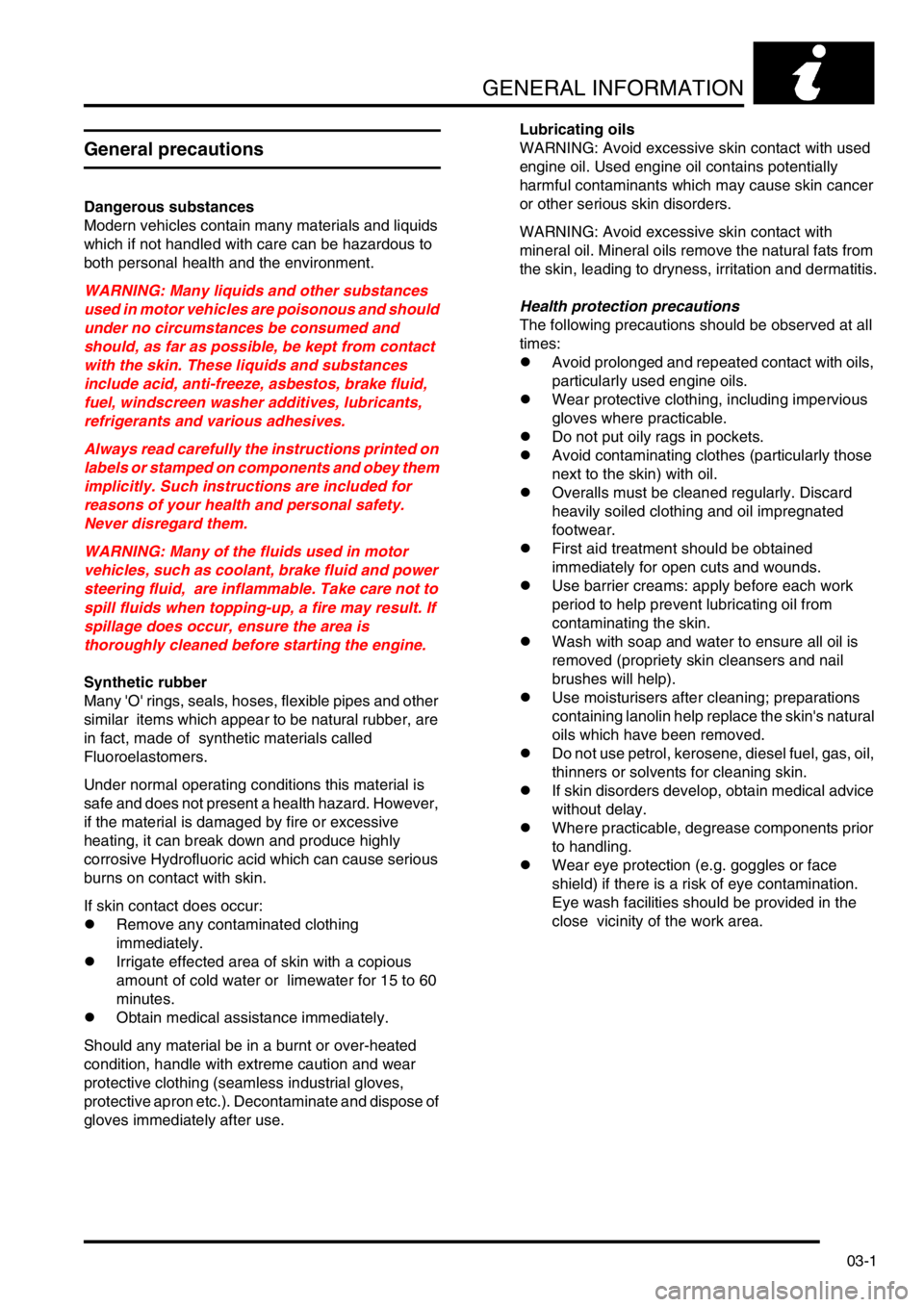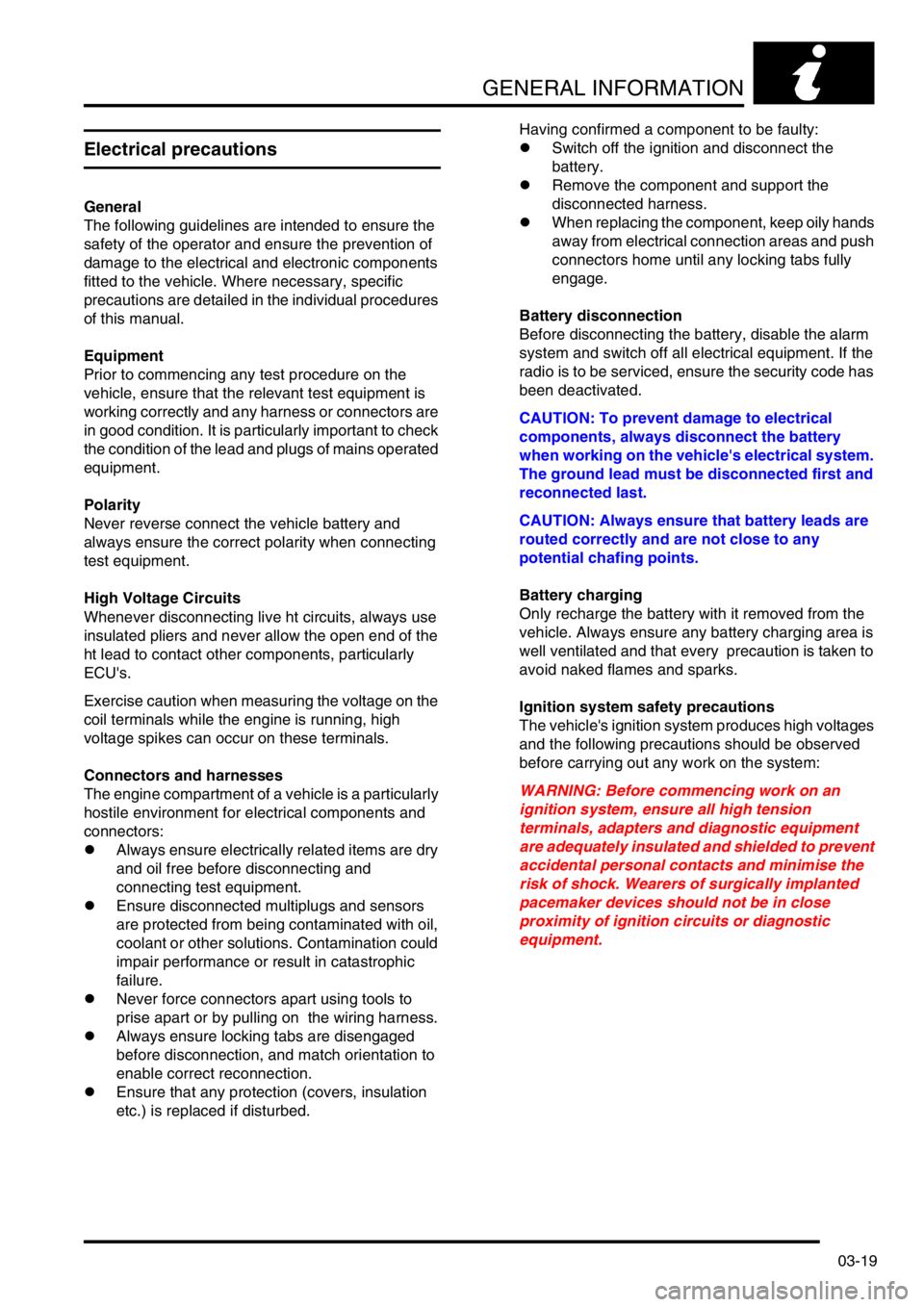engine coolant LAND ROVER FREELANDER 2001 Workshop Manual
[x] Cancel search | Manufacturer: LAND ROVER, Model Year: 2001, Model line: FREELANDER, Model: LAND ROVER FREELANDER 2001Pages: 1007, PDF Size: 23.47 MB
Page 9 of 1007

CONTENTS
6CONTENTS
EMISSION CONTROL ............................................................................. 17-1-1
ADJUSTMENTS
Evaporative loss control system (EVAPS) - leak test - NAS........................................................... 17-1-1
REPAIRS
Valve - depression limiter - Td4 ..................................................................................................... 17-1-3
Solenoid - canister purge - KV6 ...................................................................................................... 17-1-4
Charcoal canister - petrol - Non NAS ............................................................................................. 17-1-4
Charcoal canister - NAS ................................................................................................................. 17-1-5
Valve - canister purge - K1.8 .......................................................................................................... 17-1-6
Valve - EGR - Td4 .......................................................................................................................... 17-1-7
Solenoid/modulator valve - EGR - Td4 ........................................................................................... 17-1-8
Thermal valve - exhaust gas recirculation (EGR) -
Td4 Automatic transmission (hot climates) - from 03 MY ............................................................... 17-1-9
Cooler - EGR - Td4 ......................................................................................................................... 17-1-9
Module - tank leakage diagnostic (DMTL) ...................................................................................... 17-1-11
Filter - fuel leak detection pump - KV6 - NAS ................................................................................ 17-1-12
Catalytic converter - RH - KV6 - NAS ............................................................................................ 17-1-12
ENGINE MANAGEMENT SYSTEM - SIEMENS....................................... 18-3-1
REPAIRS
Spark plugs - up to 03MY ............................................................................................................... 18-3-1
Spark plugs - from 03MY ................................................................................................................ 18-3-2
Coil - each - LH bank - up to 03MY ................................................................................................ 18-3-3
Coil - each - LH bank - from 03MY ................................................................................................. 18-3-3
Coil - each - RH bank - up to 03MY ................................................................................................ 18-3-4
Coil - each - RH bank - from 03MY................................................................................................. 18-3-4
Engine control module (ECM) - Non NAS ..................................................................................... 18-3-5
Engine control module (ECM) - fuel - NAS .................................................................................... 18-3-6
Idle Air Control Valve (IACV) ......................................................................................................... 18-3-7
Sensor - intake air temperature (IAT) - NAS .................................................................................. 18-3-8
Sensor - engine coolant temperature (ECT) .................................................................................. 18-3-8
Sensor - crankshaft position (CKP) ............................................................................................... 18-3-9
Sensor - throttle position (TP) ......................................................................................................... 18-3-10
Sensor - thermostat monitoring (TM) - KV6 - NAS ........................................................................ 18-3-11
Sensor - camshaft position (CMP) ................................................................................................. 18-3-12
Sensor - knock (KS) ....................................................................................................................... 18-3-13
Switch - throttle pedal - Non NAS ................................................................................................... 18-3-13
Sensor - combined - manifold absolute pressure/Intake air temperature (MAP/IAT) ..................... 18-3-14
Sensor - throttle position (TP) - NAS - up to 03MY......................................................................... 18-3-15
Sensor - throttle position (TP) - NAS - from 03MY ......................................................................... 18-3-16
Page 28 of 1007

INTRODUCTION
01-3
Abbreviations and Symbols
A Amperes
AAP Ambient Air Pressure
AAT Ambient Air Temperature
ABDC After Bottom Dead Centre
ABS Anti-Lock Brake System
ABS / TC Anti-lock Brake System / Traction
Control
ac Alternating current
A/C Air Conditioning
ACE Active Cornering Enhancement
ACEA Association of Constructors of
European Automobiles
AFR Air Fuel Ratio
AP Ambient Pressure
ASC Anti-shunt Control
ATC Air Temperature Control
ATDC After Top Dead Centre
AUX Auxiliary
AVC Automatic Volume Control
BBDC Before Bottom Dead Centre
BBUS Battery Backed Up Sounder
BCU Body Control Unit
BDC Bottom Dead Centre
bhp Brake Horse Power
BP Boost Pressure
BPP Brake Pedal Position
BS British Standard
BTDC Before Top Dead Centre
BWD Backward
C Celsius
CAN Controller Area Network
CD Compact Disc
CDC Centre Differential Control
CDL Central Door Locking
CD - ROM Compact Disc - Read Only
Memory
CFC Chlorofluorocarbon
CHMSL Centre High Mounted Stop Lamp
CKP Crankshaft Position
CLV Calculated Load Value
cm Centimetre
cm
2Square centimetre
cm3Cubic centimetre
CMP Camshaft Position
CPP Clutch Pedal Position
CO Carbon Monoxide
CO
2Carbon Dioxide
COB Clear Over Base
CR Common Rail
CVS Canister Vent Solenoid
dB Decibels
DDM Driver's Door Module
deg. Degree, angle or temperature
DI Direct Injection
dia. DiameterDIN Deutsche Industrie Normen
(German Industrial Standards)
dc Direct current
DCV Directional Control Valve
DOHC Double Overhead Camshaft
DSP Digital Signal Processing
DTI Dial Test Indicator
DMF Dual Mass Flywheel
DVD Digital Versatile Disc
EACV Electronic Air Control Valve
EAT Electronic Automatic
Transmission
EBD Electronic Brake pressure
Distribution
ECD European Community Directive
ECM Engine Control Module
ECT Engine Coolant Temperature
ECU Electronic Control Unit
EDC Electronic Diesel Control
EEPROM Electronic Erasable
Programmable Read Only
Memory
EGR Exhaust Gas Recirculation
EKA Emergency Key Access
ELR Emergency Locking Retractor
EN European Norm
EOBD European On Board Diagnostics
EON Enhanced Other Network
ERL Electrical Reference Library
ETC Electronic Traction Control
EUI Electronic Unit Injector
EVAP Evaporative Emission
EVR Electronic Vacuum Regulator
F Fahrenheit
ft. Feet
FBH Fuel Burning Heater
FET Field Effect Transistor
FIP Fuel Injection Pump
FTC Fast Throttle Control
FWD Forward
> Greater than
g Gramme or Gravity
gal. Gallons
GMT Greenwich Mean Time
GPS Global Positioning System
hHour
hc High compression
HC Hydro Carbons
HDC Hill Descent Control
HDOP Height Dilation Of Precision
HDPE High Density Polyethylene
HFS Heated Front Screen
Hg Mercury
HO
2S Heated Oxygen Sensor
HMW High Molecular Weight
Page 32 of 1007

GENERAL INFORMATION
03-1
GENERAL INFORMATION
General precautions
Dangerous substances
Modern vehicles contain many materials and liquids
which if not handled with care can be hazardous to
both personal health and the environment.
WARNING: Many liquids and other substances
used in motor vehicles are poisonous and should
under no circumstances be consumed and
should, as far as possible, be kept from contact
with the skin. These liquids and substances
include acid, anti-freeze, asbestos, brake fluid,
fuel, windscreen washer additives, lubricants,
refrigerants and various adhesives.
Always read carefully the instructions printed on
labels or stamped on components and obey them
implicitly. Such instructions are included for
reasons of your health and personal safety.
Never disregard them.
WARNING: Many of the fluids used in motor
vehicles, such as coolant, brake fluid and power
steering fluid, are inflammable. Take care not to
spill fluids when topping-up, a fire may result. If
spillage does occur, ensure the area is
thoroughly cleaned before starting the engine.
Synthetic rubber
Many 'O' rings, seals, hoses, flexible pipes and other
similar items which appear to be natural rubber, are
in fact, made of synthetic materials called
Fluoroelastomers.
Under normal operating conditions this material is
safe and does not present a health hazard. However,
if the material is damaged by fire or excessive
heating, it can break down and produce highly
corrosive Hydrofluoric acid which can cause serious
burns on contact with skin.
If skin contact does occur:
lRemove any contaminated clothing
immediately.
lIrrigate effected area of skin with a copious
amount of cold water or limewater for 15 to 60
minutes.
lObtain medical assistance immediately.
Should any material be in a burnt or over-heated
condition, handle with extreme caution and wear
protective clothing (seamless industrial gloves,
protective apron etc.). Decontaminate and dispose of
gloves immediately after use.Lubricating oils
WARNING: Avoid excessive skin contact with used
engine oil. Used engine oil contains potentially
harmful contaminants which may cause skin cancer
or other serious skin disorders.
WARNING: Avoid excessive skin contact with
mineral oil. Mineral oils remove the natural fats from
the skin, leading to dryness, irritation and dermatitis.
Health protection precautions
The following precautions should be observed at all
times:
lAvoid prolonged and repeated contact with oils,
particularly used engine oils.
lWear protective clothing, including impervious
gloves where practicable.
lDo not put oily rags in pockets.
lAvoid contaminating clothes (particularly those
next to the skin) with oil.
lOveralls must be cleaned regularly. Discard
heavily soiled clothing and oil impregnated
footwear.
lFirst aid treatment should be obtained
immediately for open cuts and wounds.
lUse barrier creams: apply before each work
period to help prevent lubricating oil from
contaminating the skin.
lWash with soap and water to ensure all oil is
removed (propriety skin cleansers and nail
brushes will help).
lUse moisturisers after cleaning; preparations
containing lanolin help replace the skin's natural
oils which have been removed.
lDo not use petrol, kerosene, diesel fuel, gas, oil,
thinners or solvents for cleaning skin.
lIf skin disorders develop, obtain medical advice
without delay.
lWhere practicable, degrease components prior
to handling.
lWear eye protection (e.g. goggles or face
shield) if there is a risk of eye contamination.
Eye wash facilities should be provided in the
close vicinity of the work area.
Page 34 of 1007

GENERAL INFORMATION
03-3
Brake hydraulics
Observe the following recommendations when
working on the brake system:
lAlways use two spanners when loosening or
tightening brake pipe or hose connections.
lEnsure that hoses run in a natural curve and are
not kinked or twisted.
lFit brake pipes securely in their retaining clips
and ensure that the pipe run cannot contact a
potential chafing point.
lContainers used for hydraulic brake fluid must
be kept absolutely clean.
lDo not store hydraulic brake fluid in an unsealed
container, it will absorb water and in this
condition would be dangerous to use due to a
lowering of its boiling point.
lDo not allow hydraulic brake fluid to be
contaminated with mineral oil, or put new
hydraulic brake fluid in a container which has
previously contained mineral oil.
lDo not re-use hydraulic brake fluid previously
removed from the system.
lAlways use clean brake fluid or a recommended
alternative to clean hydraulic components.
lFit a blanking cap to a hydraulic union and a
plug to its socket, immediately after
disconnection of pipes and hoses to prevent the
ingress of dirt.
lAbsolute cleanliness must be observed when
working with hydraulic components.
lIt is imperative that the correct brake fittings are
used and that threads of components are
compatible.
Cooling system caps and plugs
Extreme care is necessary when removing engine
cooling system expansion tank caps and coolant
drain or bleed screws when the engine is hot, and
especially if it is overheated.
To avoid the possibility of scalding allow the engine
to cool before attempting coolant cap or plug
removal.
Environmental Precautions
General
This section provides general information which can
help to reduce adverse environmental impacts
incurred through the activities carried out in
workshops.
Emissions to air
Many of the activities that are carried out in
workshops emit gases and fumes which contribute to
global warming, depletion of the ozone layer and/or
the formation of photo-chemical smog at ground
level. By considering and controlling how the
workshop activities are carried out, these gases and
fumes can be minimised, thus reducing the damage
to the environment.
Exhaust fumes
Running car engines is an essential part of workshop
activities and exhaust fumes need to be ventilated to
atmosphere. However, the amount of time engines
are running and the position of the vehicle should be
carefully considered at all times, to reduce the
release of poisonous gases and minimise the
inconvenience to people living nearby.
Solvents
Some of the cleaning agents used are solvent based
and will evaporate to atmosphere if used carelessly,
or if cans are left unsealed. All solvent containers
should be firmly closed when not needed and solvent
should be used sparingly. Suitable alternative
materials may be available to replace some of the
commonly used solvents. Similarly, many paints are
solvent based and the spray should be minimised to
reduce solvent emissions.
Refrigerant
It is illegal to release any refrigerants into the
atmosphere. Discharge and replacement of these
materials from air conditioning units should only be
carried out using the correct equipment.
Checklist
Always adhere to the following:
Engines –
ldon't leave engines running unnecessarily;
lminimise testing times and check where the
exhaust fumes are being blown.
Page 50 of 1007

GENERAL INFORMATION
03-19
Electrical precautions
General
The following guidelines are intended to ensure the
safety of the operator and ensure the prevention of
damage to the electrical and electronic components
fitted to the vehicle. Where necessary, specific
precautions are detailed in the individual procedures
of this manual.
Equipment
Prior to commencing any test procedure on the
vehicle, ensure that the relevant test equipment is
working correctly and any harness or connectors are
in good condition. It is particularly important to check
the condition of the lead and plugs of mains operated
equipment.
Polarity
Never reverse connect the vehicle battery and
always ensure the correct polarity when connecting
test equipment.
High Voltage Circuits
Whenever disconnecting live ht circuits, always use
insulated pliers and never allow the open end of the
ht lead to contact other components, particularly
ECU's.
Exercise caution when measuring the voltage on the
coil terminals while the engine is running, high
voltage spikes can occur on these terminals.
Connectors and harnesses
The engine compartment of a vehicle is a particularly
hostile environment for electrical components and
connectors:
lAlways ensure electrically related items are dry
and oil free before disconnecting and
connecting test equipment.
lEnsure disconnected multiplugs and sensors
are protected from being contaminated with oil,
coolant or other solutions. Contamination could
impair performance or result in catastrophic
failure.
lNever force connectors apart using tools to
prise apart or by pulling on the wiring harness.
lAlways ensure locking tabs are disengaged
before disconnection, and match orientation to
enable correct reconnection.
lEnsure that any protection (covers, insulation
etc.) is replaced if disturbed.Having confirmed a component to be faulty:
lSwitch off the ignition and disconnect the
battery.
lRemove the component and support the
disconnected harness.
lWhen replacing the component, keep oily hands
away from electrical connection areas and push
connectors home until any locking tabs fully
engage.
Battery disconnection
Before disconnecting the battery, disable the alarm
system and switch off all electrical equipment. If the
radio is to be serviced, ensure the security code has
been deactivated.
CAUTION: To prevent damage to electrical
components, always disconnect the battery
when working on the vehicle's electrical system.
The ground lead must be disconnected first and
reconnected last.
CAUTION: Always ensure that battery leads are
routed correctly and are not close to any
potential chafing points.
Battery charging
Only recharge the battery with it removed from the
vehicle. Always ensure any battery charging area is
well ventilated and that every precaution is taken to
avoid naked flames and sparks.
Ignition system safety precautions
The vehicle's ignition system produces high voltages
and the following precautions should be observed
before carrying out any work on the system:
WARNING: Before commencing work on an
ignition system, ensure all high tension
terminals, adapters and diagnostic equipment
are adequately insulated and shielded to prevent
accidental personal contacts and minimise the
risk of shock. Wearers of surgically implanted
pacemaker devices should not be in close
proximity of ignition circuits or diagnostic
equipment.
Page 105 of 1007

TORQUE WRENCH SETTINGS
06-2
Engine – Td4
TORQUE DESCRIPTION METRIC IMPERIAL
Acoustic cover to engine 8 Nm 6 lbf.ft
Ancillary drive belt jockey pulley Allen bolt
*24 Nm 18 lbf.ft
Ancillary drive belt tensioner arm nut 10 Nm 7.5 lbf.ft
Big end bearing cap bolts:
⇒ Stage 15 Nm 3.5 lbf.ft
⇒ Stage 225 Nm 18 lbf.ft
⇒ Stage 3+70°+70°
Camshaft bearing cap bolts
† 10 Nm 7.5 lbf.ft
Camshaft cover bolts
† 10 Nm 7.5 lbf.ft
Camshaft sprocket retaining screw:
⇒ Stage 120 Nm 15 lbf.ft
⇒ Stage 2+35°+35°
Chain lubrication jet bolt 10 Nm 7.5 lbf.ft
Coolant rail to exhaust manifold bolts 20 Nm 15 lbf.ft
Coolant rail to exhaust manifold bolts 8 Nm 6 lbf.ft
Crankshaft pulley:
⇒ Stage 1100 Nm 74 lbf.ft
⇒ Stage 2+60 °+60 °
⇒ Stage 3+60 °+60 °
⇒ Stage 4+30 °+30 °
Crankshaft rear oil seal housing:
⇒ M6 bolts10 Nm 7.5 lbf.ft
⇒ M8 bolts22 Nm 16 lbf.ft
Cylinder block reinforcing plate 22 Nm 16 lbf.ft
Cylinder head bolts: (Stages 1 to 5 relate to bolts 1 to 11. Stage 6 is for bolt 12 only.)
⇒ Stage 1
†80 Nm 59 lbf.ft
⇒ Stage 2 - loosen all bolts
†-1/2 turn -1/2 turn
⇒ Stage 3
†50 Nm 37 lbf.ft
⇒ Stage 4
†+90°+90°
⇒ Stage 5
†+90°+90°
⇒ Stage 6 – tighten 41 mm bolt in position 12 110 Nm 81 lbf.ft
Cylinder head to timing cover Allen screws 15 Nm 11 lbf.ft
Dipstick tube to oil filter housing bolt 10 Nm 7.5 lbf.ft
Drive plate to crankshaft bolts
† 115 Nm 85 lbf.ft
EGR cooler to cylinder head and lifting bracket bolts 25 Nm 18 lbf.ft
Engine breather pipe to air cleaner housing bolt 10 Nm 7.5 lbf.ft
Engine lifting eye bolts 20 Nm 15 lbf.ft
Engine mounting bracket assembly to engine bolts 100 Nm 74 lbf.ft
Engine mounting bracket to hydramount nut 85 Nm 63 lbf.ft
Engine lower steady bracket bolts:
⇒ M1045 Nm 33 lbf.ft
⇒ M1250 Nm 37 lbf.ft
Engine steady mounting bolt 100 Nm 74 lbf.ft
Exhaust manifold to cylinder head nuts 24 Nm 18 lbf.ft
Flywheel to crankshaft bolts
† 115 Nm 85 lbf.ft
Fuel pipe bracket to oil filter housing bolt 10 Nm 7.5 lbf.ft
Fuel pipe union nuts 30 Nm 22 lbf.ft
Fuel pump drive chain lower guide Allen bolt 24 Nm 18 lbf.ft
Page 106 of 1007

TORQUE WRENCH SETTINGS
06-3
† Tighten in sequence
* Fit new bolt
Fuel pump sprocket retaining nut 65 Nm 48 lbf.ft
Fuel rail Allen screws 24 Nm 18 lbf.ft
Fuel rail to coolant rail bolts 10 Nm 7.5 lbf.ft
Fuel rail to support bracket bolts 10 Nm 7.5 lbf.ft
Glow plugs18 Nm 13 lbf.ft
Heatshield to coolant rail Allen screws 8 Nm 6 lbf.ft
Hose adaptor to cylinder head bolts 8 Nm 6 lbf.ft
LH engine mounting to gearbox bracket through bolt 100 Nm 74 lbf.ft
LH engine mounting to body 45 Nm 33 lbf.ft
Lower coolant rail support bracket bolts 15 Nm 11 lbf.ft
Main bearing cap bolts:
⇒ 1st. Stage
† 20 Nm 15 lbf.ft
⇒ 2nd Stage
† +70°+70°
Oil cooler to oil filter housing bolts 22 Nm 16 lbf.ft
Oil feed guide rail bolts 10 Nm 7.5 lbf.ft
Oil filter cap25 Nm 18 lbf.ft
Oil filter housing bolts 25 Nm 18 lbf.ft
Oil pick-up strainer to oil pump bolts 10 Nm 7.5 lbf.ft
Oil pressure switch 38 Nm 28 lbf.ft
Oil pump drive gear to oil pump drive shaft Torx bolt 25 Nm 18 lbf.ft
Oil pump to cylinder block 25 Nm 18 lbf.ft
PAS pipe clip to engine lifting eye bolt 10 Nm 7.5 lbf.ft
Sump: †
⇒ M6 bolts10 Nm 7.5 lbf.ft
⇒ M8 bolts28 Nm 21 lbf.ft
Sump drain plug28 Nm 21 lbf.ft
Sump plate bolts10 Nm 7.5 lbf.ft
Timing chain support guides 20 Nm 15 lbf.ft
Timing chain tensioner access plug 30 Nm 22 lbf.ft
Timing chain tensioner bolt 10 Nm 7.5 lbf.ft
Timing cover bolts
† 15 Nm 11 lbf.ft
Turbocharger to exhaust manifold bolts 45 Nm 33 lbf.ft
Turbocharger outlet pipe fixing bolts:
⇒ 6mm10 Nm 7.5 lbf.ft
⇒ 8mm25 Nm 18 lbf.ft
Vacuum pump bolts 22 Nm 16 lbf.ft
Page 107 of 1007

TORQUE WRENCH SETTINGS
06-4
Engine – K1.8
TORQUE DESCRIPTION METRIC IMPERIAL
Big end bearing cap dowel bolts:
⇒ Stage 120 Nm 15 lbf.ft
⇒ Stage 2+45°+45°
Bearing ladder to cylinder block bolts:
⇒ Stage 1
†++5 Nm 3.5 lbf.ft
⇒ Stage 2
† ++30 Nm 22 lbf.ft
Camshaft carrier to cylinder head bolts
†++10 Nm 7.5 lbf.ft
Camshaft cover to carrier bolts
†8 Nm 6 lbf.ft
Camshaft gear bolt 65 Nm 48 lbf.ft
Camshaft rear oil seal cover plate bolts:
⇒ Exhaust25 Nm 18 lbf.ft
⇒ Inlet6 Nm 4.5 lbf.ft
Camshaft sensor bolt 8 Nm 6 lbf.ft
Camshaft timing belt lower front cover bolts 9 Nm 7 lbf.ft
Camshaft drive belt upper front cover bolts 5 Nm 3.5 lbf.ft
Camshaft timing belt rear cover bolts 9 Nm 7 lbf.ft
Camshaft timing belt tensioner bolt
* 25 Nm 18 lbf.ft
Camshaft upper cover to rear cover bolts 5 Nm 3.5 lbf.ft
Coolant outlet elbow to cylinder head bolts 9 Nm 7 lbf.ft
Crankshaft pulley bolt 205 Nm 151 lbf.ft
Cylinder head bolts
⇒ Stage 1
†20 Nm 15 lbf.ft
⇒ Stage 2
†+180 °+180 °
⇒ Stage 3
†+180 °+180 °
Dipstick tube to cylinder block 10 Nm 7.5 lbf.ft
Dipstick tube bracket and thermostat housing to cylinder block bolt 10 Nm 7.5 lbf.ft
Engine earth lead to body nut 9 Nm 7 lbf.ft
Engine harness to oil pump housing bolts 10 Nm 7.5 lbf.ft
Engine LH gearbox mounting bracket through bolt 80 Nm 59 lbf.ft
Engine LH mounting bracket to body bolts 45 Nm 33 lbf.ft
Engine lower steady to sump mounting bracket bolt 80 Nm 59 lbf.ft
Engine lower steady bracket to sump bolts 100 Nm 74 lbf.ft
Engine lower steady to subframe bolt 80 Nm 59 lbf.ft
Engine steady to LH mounting bolt 25 Nm 18 lbf.ft
Engine steady (lower) to rear beam bolt 80 Nm 59 lbf.ft
Engine steady (lower) to sump mounting bracket bolt 80 Nm 59 lbf.ft
Engine steady (upper RH) to body bolt 80 Nm 59 lbf.ft
Engine steady (upper RH) to top arm bolt 80 Nm 59 lbf.ft
Engine to gearbox top and front cover plate bolts and nuts 80 Nm 59 lbf.ft
Flywheel to crankshaft bolts
†*80 Nm 59 lbf.ft
Front cover plate to gearbox M6 bolt 9 Nm 7 lbf.ft
Ignition coils to camshaft cover bolts 8 Nm 6 lbf.ft
Oil pick-up strainer bolt 12 Nm 9 lbf.ft
Oil pick-up strainer support bracket to oil rail bolt 12 Nm 9 lbf.ft
Oil pressure switch
+17 Nm 12.5 lbf.ft
Oil pressure relief valve plug
+25 Nm 18 lbf.ft
Oil pump to cylinder block bolts
†*10 Nm 7.5 lbf.ft
Oil rail to bearing ladder nuts
++9 Nm 7 lbf.ft
Page 112 of 1007

TORQUE WRENCH SETTINGS
06-9
Engine Management System – EDC
TORQUE DESCRIPTION METRIC IMPERIAL
Camshaft position (CMP) sensor Torx screw 8 Nm 6 lbf.ft
Crankshaft position (CKP) sensor Allen screw 8 Nm 6 lbf.ft
'E' box cover Allen screws 2 Nm 1.5 lbf.ft
Engine coolant temperature sensor (ECT) 15 Nm 11 lbf.ft
Engine breather pipe to air cleaner housing bolt 6 Nm 4.4 lbf.ft
Mass air flow / inlet air temperature MAF/IAT sensor to air cleaner housing 6 Nm 4.4 lbf.ft
Throttle pedal to stud nuts 25 Nm 18 lbf.ft
Throttle Position (TP) sensor nuts and bolts 10 Nm 7 lbf.ft
TP sensor release lever nut 10 Nm 7 lbf.ft
Page 113 of 1007

TORQUE WRENCH SETTINGS
06-10
Engine Management System – MEMS
+ Apply sealant, Part No. STC 50552 to threads
TORQUE DESCRIPTION METRIC IMPERIAL
Camshaft position (CMP) sensor bolt 8 Nm 6 lbf.ft
Crankshaft position sensor (CKP) to housing bolt 8 Nm 6 lbf.ft
'E' box retaining clip nut 9 Nm 7 lbf.ft
Engine coolant temperature (ECT) sensor to housing bolt
*15 Nm 11 lbf.ft
Fuel cut-off (inertia) switch nuts 2 Nm 1.5 lbf.ft
Idle air control (IAC) valve to manifold Torx screws 1.5 Nm 1.1 lbf.ft
Ignition coil and ht lead cover bolts 10 Nm 7.5 lbf.ft
Ignition coil mounting bolts 8 Nm 6 lbf.ft
Spark plugs to cylinder head 27 Nm 20 lbf.ft
Throttle body to inlet manifold chamber Torx screws (KV6) 7 Nm 5 lbf.ft
Throttle actuator support bracket to throttle body Torx screws
(vehicles with cruise control only)9 Nm 7 lbf.ft
Throttle position sensor to housing Torx screws 1.5 Nm 1.1 lbf.ft